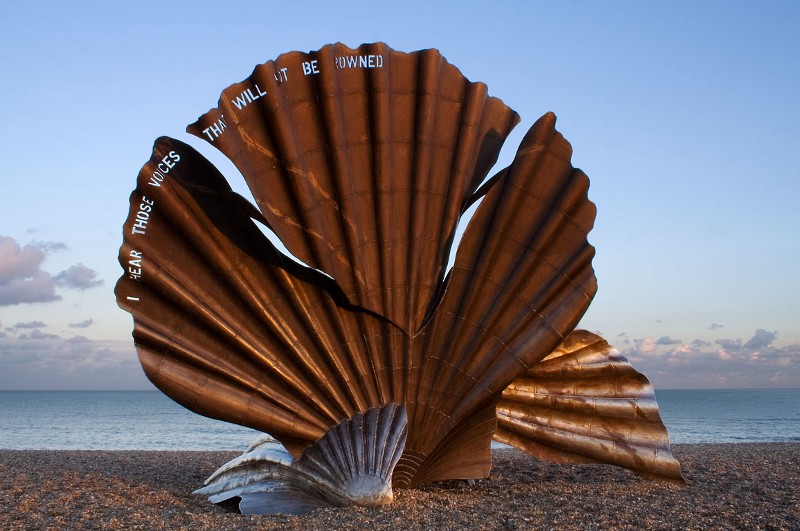
‘Time will not forget: The dead are witness, And fate is blind.’ Peter Grimes, 1945
The sun was shining in the English coastal town of Aldeburgh, but there was still a sense of foreboding in the grey, blustery sea.
Standing on the pebble beach it seemed as if there was no end to the dark rolling waters that stretched as far as the eye could see.
This is the part of the world where composer Benjamin Britten was born in 1913. This is the part of the world that inspired his most famous works such as Peter Grimes (1945) and Billy Budd (1951). This is the part of the world where Britten and his partner Peter Pears made their home, established the Aldeburgh music festival, and the Snape Maltings Concert Hall.
I caught the train from London’s Liverpool Street station out to Ipswich and then changed on to a single-carriage local train which rattled through the green Suffolk countryside to the town of Saxmundham.
From there I caught a taxi to the small seaside village of Aldeburgh and checked in to the Brudenell Hotel. This is a smart, modern hotel with an unassailable position right on the pebble beach in the heart of the village.
Staring out the window of my room the ocean seemed so close that it almost felt as if you could reach out and touch it — like you were on a cruise ship in the middle of the sea. After dinner at the hotel — local asparagus and traditional fish and chips — I slept soundly with the crashing of the waves providing a steady rhythm for my dreams.
A useful way to explore Aldeburgh (while also getting a sense of Britten’s world) is to follow the self-guided walking tour which has been branded as The Britten Trail. Maps can be downloaded from the tourist office website but are also available at hotels and around the town. Highlights for me were the ancient Moot Hall which is the setting for the opening scene of Peter Grimes; the grassy graveyard of the Aldeburgh Parish Church where Britten and Pears are buried side-by-side, their lives commemorated with simple headstones; and the Scallop (inscribed with ‘I hear those voices that will not be drowned’ from Peter Grimes) — an evocative sculpture, designed by Maggi Hambling and erected in 2003.
From Aldeburgh I took a taxi out to Snape Maltings Concert Hall. Built in the mid-nineteenth century for the roasting of barley as part of the process of brewing beer, the maltings at Snape were one of the largest in the region until operations ceased in 1965. Seeing the potential of the sprawling complex of brick buildings, Britten converted the largest malthouse at Snape into a concert hall with over 800 seats — opening in 1967 this new venue delivered a much needed expansion of capacity for the Aldeburgh Music Festival. I met with Marc Ernesti from Aldeburgh Music who gave me a tour of the impressive facilities which have grown to become a creative campus for rehearsal, education, and performance.
From what was begun by Britten and Pears as an annual festival, Aldeburgh Music has grown to deliver an annual program of events as well as artist development and education programs.
From Snape I took a taxi across to The Red House on the outskirts of Aldeburgh — the house where Britten and Pears lived for many years and which has now been transformed into an exhibition space and archive centre. I met with Kevin Gosling of the Britten-Pears Foundation which manages the property and much of the couple’s legacy. Britten hoarded vast amounts of material from his childhood and his many creative endeavours, and the exhibition that has been curated from the archives is a fascinating glimpse into the life and creative process of the composer. It’s particularly exciting to be able to view Britten’s studio (where many of his works were brought to life); and the modernist library which hosted rehearsals and recitals — both spaces have now been fully restored and there is a real sense that Britten and Pears have just momentarily stepped out of the room.
Aldeburgh is worth they journey. It’s rare to be able to experience a place that has such a direct connection with a composer of the stature of Britten — you can feel his presence, see his inspiration, and appreciate the high regard in which he was held by his local community.
‘I am native. Rooted here.’ Peter Grimes, 1945
Interesting post on this artist bio. I thought it was curiously unknown why you used the word "gay" in the title of your post, but not in the actual posting. For whatever reason you chose to make it this way, I thought it gave a unique aspect to your post and also to the artist himself. I was an art history major in college and actually remember Peter Grims being mentioned in musician history. Nice post.
Downvoting a post can decrease pending rewards and make it less visible. Common reasons:
Submit
Thanks! It's a piece I wrote a while ago for Huffington Post, just thought I'd see how it would work here with a slightly more punchy headline.
Downvoting a post can decrease pending rewards and make it less visible. Common reasons:
Submit
Wow, absolutely gorgeous photos! @g-tv
Downvoting a post can decrease pending rewards and make it less visible. Common reasons:
Submit
Hi! I am a robot. I just upvoted you! I found similar content that readers might be interested in:
http://www.huffingtonpost.co.uk/gareth-johnson/basking-in-the-brilliance-of-britten_b_3403804.html
Downvoting a post can decrease pending rewards and make it less visible. Common reasons:
Submit